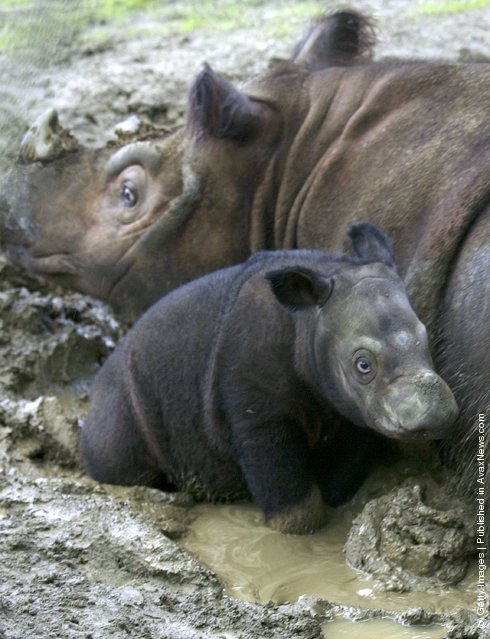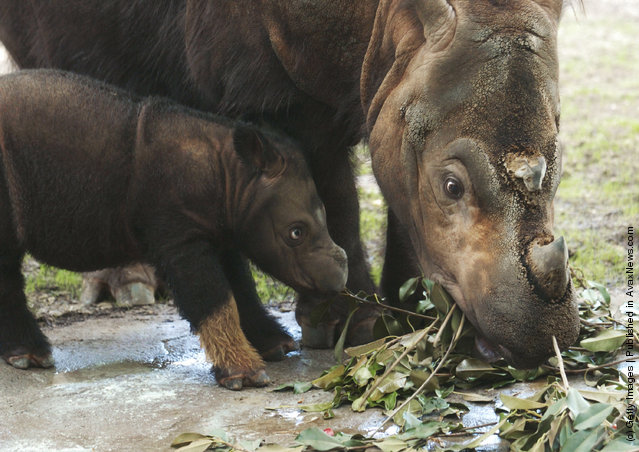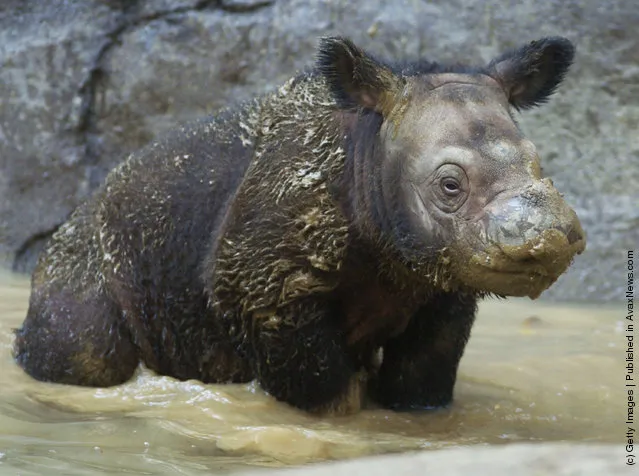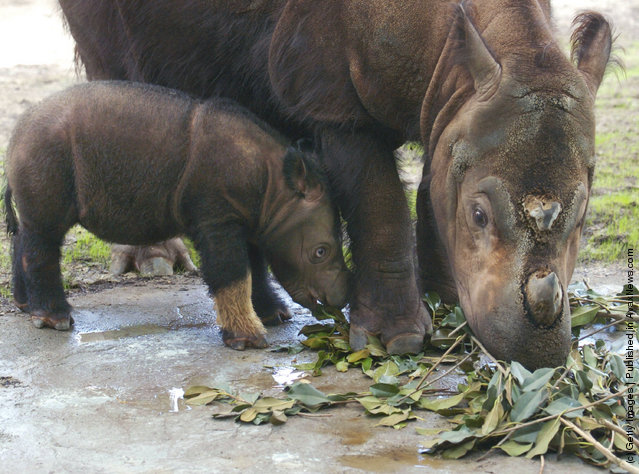“The Sumatran Rhinoceros (Dicerorhinus sumatrensis) is a member of the family Rhinocerotidae and one of five extant rhinoceroses. It is the only extant species of the genus Dicerorhinus. It is the smallest rhinoceros, standing about 120–145 centimetres (3.9–4.76 ft) high at the shoulder, with a body length of 250 centimetres (8.2 ft) and weight of 500–800 kilograms (1,100–1,800 lb). Like the African species, it has two horns; the larger is the nasal horn, typically 15–25 centimetres (5.9–9.8 in), while the other horn is typically a stub. A coat of reddish-brown hair covers most of the Sumatran Rhino's body.
Members of the species once inhabited rainforests, swamps and cloud forests in India, Bhutan, Bangladesh, Myanmar, Laos, Thailand, Malaysia, Indonesia, and China. In historical times they lived in southwest China, particularly in Sichuan. They are now critically endangered, with only six substantial populations in the wild: four on Sumatra, one on Borneo, and one in the Malay Peninsula. Their numbers are difficult to determine because they are solitary animals that are widely scattered across their range, but they are estimated to number fewer than 275. The decline in the number of Sumatran Rhinoceros is attributed primarily to poaching for their horns, which are highly valued in traditional Chinese medicine, fetching as much as US$30,000 per kilogram on the black market.
The Sumatran Rhino is a mostly solitary animal except for courtship and child-rearing. It is the most vocal rhino species and also communicates through marking soil with its feet, twisting saplings into patterns, and leaving excrement. The species is much better studied than the similarly reclusive Javan Rhinoceros, in part because of a program that brought 40 Sumatran Rhinos into captivity with the goal of preserving the species. The program was considered a disaster even by its initiator; most of the rhinos died and no offspring were produced for nearly 20 years, representing an even worse population decline than in the wild”. – Wikipedia
Photos: Emi, a Sumatran rhinoceros lies in the mud with her three-week-old female calf at the Cincinnati Zoo and Botanical Garden August 19, 2004 in Cincinnati, Ohio. Emi made history by becoming the first Sumatran rhino to produce two calves in captivity. (Photo by Mike Simons/Getty Images)
Members of the species once inhabited rainforests, swamps and cloud forests in India, Bhutan, Bangladesh, Myanmar, Laos, Thailand, Malaysia, Indonesia, and China. In historical times they lived in southwest China, particularly in Sichuan. They are now critically endangered, with only six substantial populations in the wild: four on Sumatra, one on Borneo, and one in the Malay Peninsula. Their numbers are difficult to determine because they are solitary animals that are widely scattered across their range, but they are estimated to number fewer than 275. The decline in the number of Sumatran Rhinoceros is attributed primarily to poaching for their horns, which are highly valued in traditional Chinese medicine, fetching as much as US$30,000 per kilogram on the black market.
The Sumatran Rhino is a mostly solitary animal except for courtship and child-rearing. It is the most vocal rhino species and also communicates through marking soil with its feet, twisting saplings into patterns, and leaving excrement. The species is much better studied than the similarly reclusive Javan Rhinoceros, in part because of a program that brought 40 Sumatran Rhinos into captivity with the goal of preserving the species. The program was considered a disaster even by its initiator; most of the rhinos died and no offspring were produced for nearly 20 years, representing an even worse population decline than in the wild”. – Wikipedia
Photos: Emi, a Sumatran rhinoceros lies in the mud with her three-week-old female calf at the Cincinnati Zoo and Botanical Garden August 19, 2004 in Cincinnati, Ohio. Emi made history by becoming the first Sumatran rhino to produce two calves in captivity. (Photo by Mike Simons/Getty Images)





22 Jun 2011 12:37:00,
post received
0 comments
